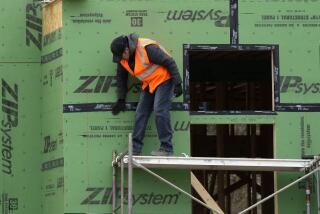Housing Starts Hit 7-Month High : Economy: The government also reports a rise in U.S. factory output. Analysts say the data points to a slow but steady recovery.
- Share via
WASHINGTON — Housing starts climbed in November to their highest level in seven months and factory output rose, the government said Wednesday, in the latest signs that the economy is in a modest but sustainable recovery.
The Commerce Department said housing starts rose last month to a seasonally adjusted annual rate of 1.24 million units from 1.22 million in October. Regionally, housing starts posted 6.3% advances in both the South and West but registered a 4.8% drop in the Northeast and plunged 8.6% in the Midwest.
Most analysts weren’t surprised by the 6.3% rise in housing starts in the West because permits to build new homes in California had risen a near-identical amount the previous month.
“California accounts for most of the (construction) activity in the West, so the rise in October permits was a precursor to a rise in starts for November,” said Ben Bartolotto, research director of the Burbank-based Construction Industry Research Board.
Bartolotto predicts that about 95,000 homes will be built in California this year, down 10.3% from 1991 and the lowest level of activity in a decade.
But starts in the state should rise 20% next year, Bartolotto said, as the economy continues to strengthen and lenders become more willing to finance new developments.
The November rise in starts nationwide was slightly lower than Wall Street estimates of 1.25 million units, but still was at the highest level since a rate of 1.34 million units in March.
At the same time, the Federal Reserve reported that output at factories, mines and utilities rose for a second straight month in November.
Production was up 0.4% last month after a revised 0.5% advance in October, the central bank said. The October increase previously had been reported as 0.3%.
The back-to-back gains more than offset declines posted in late summer, when it was feared that the economy was in danger of stalling out again.
The Fed said industry operated at 78.9% of capacity in November, the highest level since July’s 79.1% rate.
The new data came just a day after President-elect Bill Clinton made it clear that he intends to wait as long as possible to see which way the economy is going before deciding on his stimulus package.
Analysts said the new data suggested that the recovery, although unusual, shows some of the basic, fundamental patterns of past upturns, pointing to a slow but steady improvement.
In a traditional recovery, housing leads the way. It is followed by industrial production, and finally by capital spending as industry adds to its ability to produce.
“Housing led the recovery in the first quarter, and it now appears that industry is taking over and playing its traditional role,” said analyst Daryl Delano of Cahners Economics.
He and others expect the housing improvement to slow next year as industrial production gains further steam.
After a two-day conference with many of the country’s corporate and economic elite, Clinton was weighing what steps, if any, would be appropriate to keep the recovery moving after he takes office Jan. 20.
Analysts said that any decision will have to take into account the impact on America’s huge annual budget deficit, which has snowballed into a $4-trillion mountain of debt.
More to Read
Inside the business of entertainment
The Wide Shot brings you news, analysis and insights on everything from streaming wars to production — and what it all means for the future.
You may occasionally receive promotional content from the Los Angeles Times.










